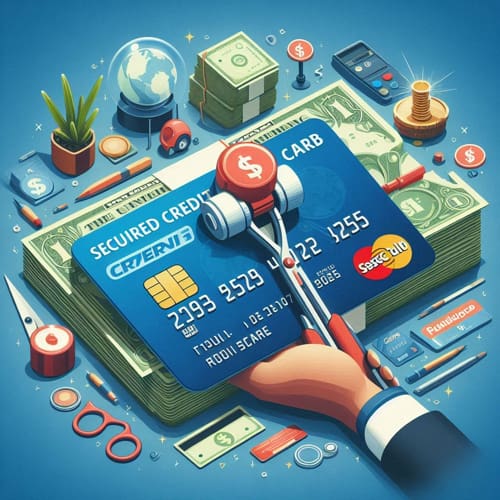Secured Credit Cards in 2025: Best Options to Rebuild Credit
Secured Credit Cards in 2025: Best Options to Rebuild Credit – Your Path to Prime Status in 2026
Introduction: The Essential Tool for a Financial Reset: 2025 & Planning for 2026
A low FICO score or lack of credit history severely limits financial access in the US. Securing one of the Best Secured Credit Cards in 2025 is the most effective solution. These cards require a refundable cash deposit. The deposit acts as collateral. This structure minimizes the risk for the issuer. It guarantees approval for almost anyone needing to build or rebuild credit. Using a secured card responsibly is a direct path to a high FICO score. It unlocks superior financial products.
In 2025, the secured card market focuses on a clear graduation path. Issuers understand that today’s secured user is tomorrow’s prime customer. Borrowers must select a card that reports to all three major credit bureaus. They must also look for a clear upgrade policy. This comprehensive guide defines how secured cards work. It identifies the top-performing cards for credit improvement. It details the essential rules for maximizing credit rebuilding. This resource provides a strategic blueprint for boosting credit health in 2025 and achieving financial independence throughout 2026.
## Secured Cards: The Mechanics of Credit Rebuilding
A secured card is essentially a training tool. It leverages your own money to build a positive history.
1. The Security Deposit (Collateral)
The cardholder provides a deposit (typically $200 to $2,500). This deposit becomes the card’s credit limit. The deposit is held by the bank. It secures the debt.
2. The Credit Limit
The limit usually equals the deposit amount. This small limit encourages careful, low-utilization spending. Low utilization is critical for FICO scoring.
3. Reporting to Credit Bureaus
The most important feature is credit reporting. Secured cards report usage to Equifax, Experian, and TransUnion. Lenders cannot distinguish a secured card from an unsecured card on the report. The history built is identical.
4. Deposit Refund (Graduation)
After 6-12 months of excellent, on-time payments, the card issuer may “graduate” the card. They upgrade it to an unsecured card. The original security deposit is then refunded.
## Best Secured Cards of 2025: Key Features to Prioritize
Do not choose a secured card based on rewards. Choose it based on its ability to transition you quickly to prime status.
1. Clear Graduation Path
Priority Feature: The card must explicitly state a path to upgrading the card and returning the deposit. This is the ultimate goal. A guaranteed path ensures the deposit is not tied up forever.
2. No Annual Fee
Secured cards should be low-cost. Always choose a card with a $0 annual fee. Paying a fee only delays the financial reset.
3. Reports to All Three Bureaus
Ensure the card reports to Equifax, Experian, and TransUnion. Reporting to all three maximizes the visibility and impact of the positive credit history.
4. Potential for Higher Limits
Some secured cards allow the cardholder to add to the initial deposit. This increases the credit limit. A higher limit makes achieving low utilization easier.
5. Competitive APR (A Secondary Concern)
While the goal is to never carry a balance, a lower APR (e.g., 25% vs. 30%) is a safety net. This protects you in an emergency.
## The 4-Step FICO Score Rebuilding Plan
FICO scoring is largely driven by payment history and utilization. Focus strictly on these two factors.
Step 1: Execute Flawless Payment History (35% of Score)
Pay on time, every single month. This is non-negotiable. Even a single late payment (30 days past due) can negate a year of positive credit building. Set up auto-pay for the full statement amount.
Step 2: Master Credit Utilization (30% of Score)
This factor can be manipulated for rapid score increases. Keep the balance used below 10% of the credit limit.
- Example: With a $500 limit, the balance reported on the statement must be kept below $50.
Step 3: Use the Card for Small, Consistent Charges
Use the card like a tool, not a spending source. Charge only one or two small, recurring expenses (e.g., a streaming subscription or a coffee budget). Pay the full balance off every week.
Step 4: Time Your Payments for Maximum Impact (The Advanced Trick)
Do not wait for the due date. Pay the balance down to near zero one week before the statement closing date. This ensures the credit bureau sees the low balance. Pay the remaining balance by the due date.
## Pitfalls to Avoid in the Rebuilding Process
Mistakes with a secured card are extremely costly. Avoid these common errors that delay the refund and halt score progress.
Pitfall 1: Maxing Out the Limit
Using the full $500 limit is a disaster. This results in 100% utilization. This will crush the FICO score, regardless of an on-time payment. Keep usage low.
Pitfall 2: Confusing the Deposit with the Balance
Do not think of the security deposit as the money available for spending. The deposit is collateral. The spending limit is the amount of the deposit.
Pitfall 3: Not Using the Card at All
If you never use the card, the credit bureaus have no activity to report. Credit history will not build. Use it for small, necessary expenses.
Pitfall 4: Applying for Too Many New Cards
Avoid opening additional credit accounts while working to rebuild. Too many hard inquiries (applications) signal financial desperation. Focus on perfecting the single secured card.
## Strategy for 2026: The Transition to Financial Freedom
Success with a secured card in 2025 provides tremendous financial leverage in 2026.
1. Request the Graduation
- 2025 Action: After 12 months of perfect use, actively call the issuer and request a formal account review for graduation. Do not wait for an automatic process.
- 2026 Benefit: The card upgrades to unsecured status. The cash deposit is returned. This cash can then be redirected to an emergency fund.
2. Open a Second Prime Card
- 2025 Action: Once the FICO score is consistently over 700, apply for a premium, unsecured rewards card (e.g., a travel card).
- 2026 Benefit: The new, high credit limit immediately lowers the overall utilization ratio. This provides better financial stability and maximizes rewards earning.
3. Use the High FICO for Loans
- 2025 Action: Maintain the high FICO status diligently.
- 2026 Benefit: When applying for a major loan (auto or mortgage) in 2026, the high score will secure the best “prime” interest rates. This translates directly into thousands of dollars in savings.
4. Keep the Old Account Active
- 2025 Action: Once upgraded, keep the original secured card account open and active.
- 2026 Benefit: This ensures that the history built in 2025 remains the oldest account on the report. This lengthens the average age of credit and sustains a high FICO score.
## Final Word: Discipline Paves the Road to Recovery
Securing the Best Secured Credit Cards in 2025 is the necessary first step on the journey to financial recovery. Therefore, the borrower must choose a card with a clear path to graduation and a $0 annual fee. They must adhere to a strict payment schedule. They must rigorously maintain a credit utilization ratio below the 10% threshold. By treating this card as a disciplined credit-building tool, consumers guarantee a high FICO score. This unlocks better financial products and maximizes opportunities for stability and savings throughout 2026 and their entire financial life.

